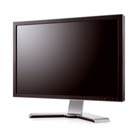
Most computer users purchase a monitor when they buy their computer, and in the case of laptops the screen is built right in. Increasingly, consumers are buying new monitors for a number of uses. Many laptop users buy a separate monitor for use at home, providing them with a better display option for movies, video games, and graphics applications. Some desktop users purchase a second monitor to allow greater productivity – the extra monitor allows more windows to be displayed simultaneously. Test drive a larger model to experience first hand the benefits of a new monitor.
Contents
Older CRT monitors have been almost completely phased out, and the market is currently dominated by LCD technology (liquid crystal display), which offer distinct advantages over the older models in terms of price, resolution, and energy efficiency. Plasma display technology has begun to enter the field, but the advantages in display quality are balanced by additional size and energy usage.
Some of today's monitors are HDTV capable, a definite necessity for consumers who use their monitors to watch DVDs and full-motion video, or play video games. These models may even have television tuners built-in, adding to their versatility. More expensive monitors feature built-in speakers to optimize the audio environment. This is particularly useful for gamers and musicians with a laptop, who use the monitor for home computing applications.
Screen Size: This is the most critical factor to consider when purchasing a monitor for the overwhelming majority of consumers. Graphics professionals, gamers, and users who enjoy movies and full-motion video will appreciate the convenience of larger monitors, those of 22” and above. Anyone will notice the welcome difference in productivity and ease-of-use provided by a monitor upgrade from the common 15-17” range to the increasingly popular 19-24” range. At the higher end of the market, plasma HDTV models up to 52” that are indistinguishable from televisions are available.
Aspect Ratio: Although some people are still using traditional 5:4 monitor when surf on the internet, the vast majority of monitors available for purchase today that feature an aspect ratio of 16:9 or 16:10 are dominating the market, because most consumers want to keep pace with gaming and movie display standards that have trended toward an increased horizontal component.
Response Time: This property measures how quickly the monitor's pixels can change from one color to the next. In theory, a low response time signifies an LCD with minimal motion artifacts in moving images. A rapid response time eliminates image ghosting and delivers a crisper picture. Obviously, this is of crucial importance to gamers, movie watchers, and consumers with high-end graphics applications, who should select a model that delivers a response time of 8ms (milliseconds) or better.
Brightness: Measured in candelas, 200cd/m2 is the brightness standard for LCD monitors, and will prove more than acceptable for almost all applications. High-end gamers might desire additional brightness, which allows for greater contrast and distinction in the range of details.
LED Backlight: Today, monitors with LED backlight, have been quickly gaining popularity. LED backlit monitors have high color gamuts and provide more accurate colors, they are always superthin and have lower power consumption. LED backlights take less of a toll on the environment when it's time to dispose of them.
Displayport: When looking through the monitor’s specs, you should check out if it has a DVI input. The DVI interface (or the DVI-compatible HDMI) is currently available on all discrete and on many integrated graphics cards. Compared to an analog interface, it guarantees a sharp and high-quality picture. An HDMI connection is used to connect the display to a high-definition source, such as a Blu-ray player or video game system. HDMI connections have become more common recently. If you're planning to use your monitor as a television, this is an essential feature.
There are numerous popular brands of monitors, and many manufacturers have staked a claim to a specific portion of the market. Acer, as it has done with it's netbook and laptop offerings, has focused on affordability above all else – their models lack many luxury add-ons, but offer the best performance for your dollar. Asus and ViewSonic feature mid-range monitors that offer buyers a little bit of everything. Samsung and LG have focused on the higher end of the market, and their models are loaded with the bells and whistles that advanced users demand.
 alaTest USA
alaTest USA alaTest UK
alaTest UK alaTest Deutschland
alaTest Deutschland alaTest France
alaTest France alaTest Italia
alaTest Italia alaTest España
alaTest España




 Drive sales with reviews on your site
Learn more about our B2B solutions
Drive sales with reviews on your site
Learn more about our B2B solutions